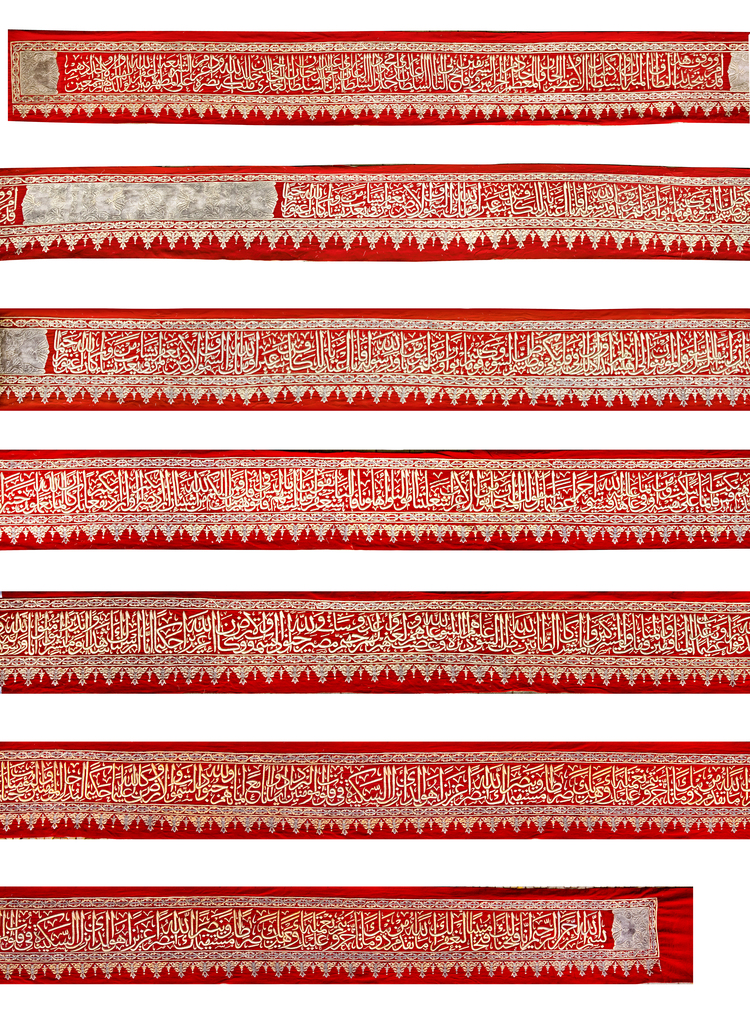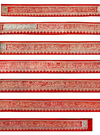Lot 297 AN UNIQUE AND COMPLETE OTTOMAN GILT AND SILVER-EMBROIDERED BELT OF THE PROPHET'S TOMB/ NITAQ, COMMISSIONED BY SULTAN MAHMUD II AND DATED 1234 AH/1818 AD
An Ottoman silk, gilt, and silver-thread embroidered calligraphic band (Nitaq) from the Prophet's tomb in Medina.
Embroidered name of Sultan Mahmud II, dated 1234 AH / 1818 AD.
Calligrapher: Sultan Mahmud II.
Measurement: 63 cm by 33.55 meters.
Of elongated rectangular form, the crimson red silk ground is heavily embroidered in silver and gilt wires, featuring chain and floral borders above a band of gilt and silver-wired floral motifs. The main ground is divided into three sections, with two large cartouches, each containing an elaborate frieze of inscriptions in elegant Thuluth script in gilt and silver wires.
The first large cartouche is flanked on both sides by two panels heavily embroidered with gilt floral motifs on a silver-embroidered ground, enclosing a large inscription in elegant Thuluth script in gilt-embroidered wires.
Inscriptions: Verses 1-14 from Surah Al-Fath (The Victory).
The small central cartouche is embroidered with gilt floral motifs, enclosing the name of Sultan Mahmud II bin Abdul-Hamid Khan and dated 1234 AH / 1818 AD on a heavily silver-embroidered ground.
The second large cartouche is flanked on both sides by two panels heavily embroidered with gilt floral motifs on a silver-embroidered ground, enclosing a large inscription in elegant Thuluth script in gilt-embroidered wires.
Inscriptions: The renewal of this holy band (Nitaq) was ordered and inscribed by the great Sultan, the almighty ruler, Servant of the Haramayn al-Sharifayn (The Two Holy Mosques), the second conqueror Sultan Ghazi Mahmud Khan, son of the conqueror Sultan Ghazi Abdul Hamid I Khan, son of the conqueror Sultan Ghazi Ahmed Khan.
May Allah render his state/reign eternal and dedicate his victories to our pure faith, Islam. Amen. May Allah forgive the sins of his parents and ancestors.
Catalogue Note:
The interior walls of the Shrine of the Prophet Muhammad (Rawda) in the Masjid al-Nabawi (Mosque of the Prophet) in Medina were adorned with exquisite textiles similar to those used for the Ka‘ba in Mecca. However, unlike the Meccan Kiswah, which is replaced annually, the Kiswah of the Rawda was changed far less frequently. Protected within the sacred chamber, it remained shielded from human contact and environmental wear.
Historically, while the Kiswah of the Ka‘ba was traditionally produced in Egypt, the textiles of the Rawda were most likely crafted in Ottoman Turkey. The intricate designs and high-quality craftsmanship reflected the deep reverence for this sacred space. The belt of the Prophet’s tomb was attached to a zigzag-patterned curtain that draped over the exterior walls of the Maqsurah, the enclosure surrounding his tomb chamber.
The Rawda holds immense spiritual significance in Islam. It is regarded as a "garden from the gardens of Paradise," as mentioned in Hadith, and is a highly revered space where pilgrims strive to pray. Marked distinctly by a green carpet, the Rawda stands out from the surrounding red-carpeted sections of the mosque, symbolizing its unique sanctity.
Literature:
A similar piece, dated AH 1206, is housed in the Topkapi Palace Museum, Istanbul. See Hülya Tezcan: Astaar al-Haramayn, Istanbul, 1996, pp. 160-161.
A similar but incomplete piece was sold at Christie’s, London, on 26 April 2005, lot 50.
A similar section of the belt, featuring the Tughra of Sultan Selim III, is part of the Khalili Collection, accession number TXT 261.










